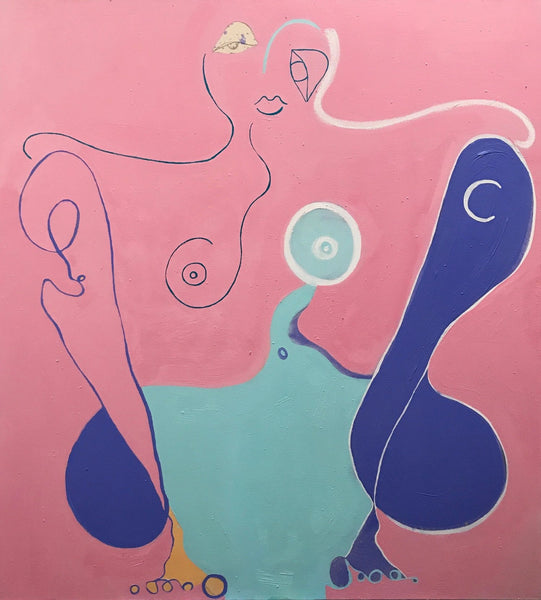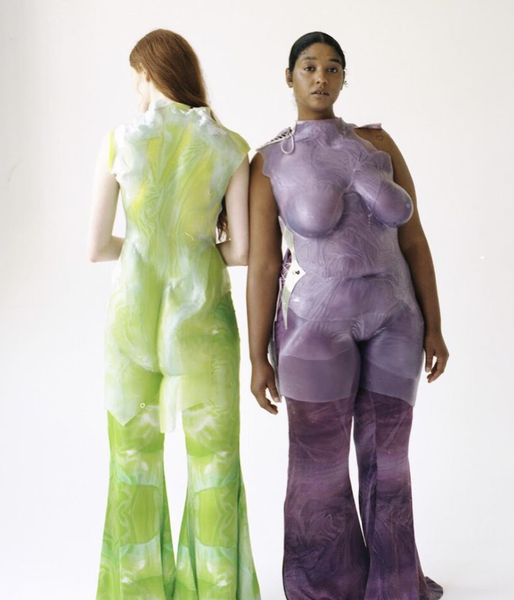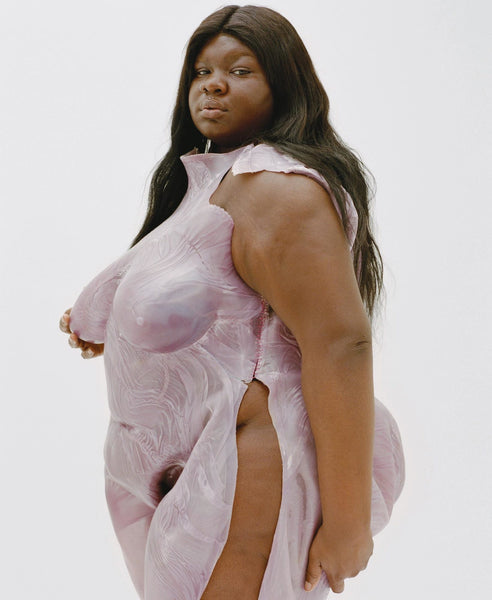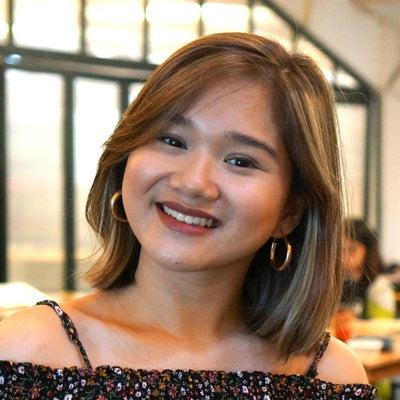For as long as I can remember, I struggled with my body. At 12, I used to shrink at the sight of myself - thick thighs and developing breasts. I hated wearing miniskirts and made sure that the blouses I bought from the department store were unrevealing and twice my actual size. At such a young age, I already had such discomfort for my own body and a visceral fear of being seen. This fear brought feelings of shame (Why wasn’t I as confident as the popular girls in my class?) and unworthiness. Even with my high marks, I believed I was the last on anybody’s list.
Junior prom scared me, I was harried from nervous anticipation. The girls in my class flocked to the steel lockers during break to talk about underarm and leg shaving, last-minute diets, the silhouettes of their gowns, while hoping that their senior prom dates would pass by the hallway. Like them, I drastically lost weight - 20 to 30 pounds - in a span of a few months.
I wasn’t familiar with the concept of body positivity then, as I am now. I wonder if I’d known about it then, would I have been easier on myself? Or would I have felt guilty of my shame amidst the empowering cries to “love and be proud of your own body”?
There was a normalcy to our struggles; a passive acceptance to sculpt and shave our bodies into pristine and shiny artifacts for the adolescent boys we sought attention from. Looking back, we were convinced that our bodies had to concede to our own social fantasies and ideas of Filipina beauty.
The Body Positivity Movement
My difficult relationship with my body, borne out of some cultural ideals, can be derived from a more universal female experience of internalized hostility to women’s bodies. The concept of body positivity started out radical and fringe, as a tenet of the fat acceptance movement of the 1960s in the US when the cases of anorexia and bulimia were escalating and psychiatrists were only starting to classify it as an actual mental disorder. The term itself was borne out of treatment for anorexia recovery in 1996.
Exactly when and how the body positivity movement started in the Philippines is undetermined, but as Filipinas, we’ve always caught up with the times, even when more traditional institutions remind us otherwise. The virgin-whore dichotomy is more potent in Filipino society where most households lead by the teachings of Catholicism. More so, the Maria Clara ideal still forces Filipinas to think of hiding our bodies as a moral imperative - our culture’s idea of what’s good. I remember one cautionary tale of a Catholic school girl in Manila whose own graduation got postponed after she posted a bikini photo on Facebook weeks before the ceremony.
More than a decade later, I’m part of the social media generation that ushered a more palatable version of the body positivity movement (to the dismay of feminist scholars and activists). It’s everywhere from catchy statement shirts to fitness ads. It’s easy for us to be reminded to love our bodies and embrace our curves when it’s sold as pastel-themed coffee mugs and laptop stickers.
Social media platforms like Instagram have afforded us the freedom to express ourselves despite our own cultural standards and even completely break away from them. We often admonish our friends for feeling insecure about their bodies or when they complain about drinking too much milk tea. The language of body positivity has become so commonplace that when we hear contrary self-talk, we quickly throw empty encouragements like salve to a first-degree burn. Completely ignoring the underlying implication: poor body-image was, and is still, a silent plague among many of our Filipina friends and colleagues.
Body Positivity As a Filipina Today
There’s a deeply embedded culture of toxic body shaming in the Philippines that’s often been lightly taken as comic relief, endearment, or even as a form of greeting by Filipinos who don’t see its actual mental repercussions.
I remember the personal crisis I went through when one of our helpers at home casually quipped, “Bakit ka tumaba? Ang ganda ganda mo na noon eh! (Why did you gain weight? You were already so pretty!)”. I was on the phone for an hour crying and processing what I just heard with a friend. I felt so many emotions at once: self-hatred, disappointment, resentment, defeat and a bright-red rage for losing control over my own body. My irrational anxiety over gaining weight, of course, is a product of years of false advertising and sexist beauty standards. We’re hardwired to think that beauty is tied to our perceived social worth.
I was in disbelief because I felt that in the past several months, I reached a level of positive awareness. I ate, but I didn’t overindulge; I succumbed to my cravings, thinking it was well-deserved for how often I worked my body to exertion at the boxing gym - only to have gained a couple of pounds in the end. I didn’t know my body after all. I went on a full on diet after that - a sick self-satisfying cycle - of no rice, just greens and protein for breakfast and black coffee. Of course, my self-hatred fueled the deprivation that followed and the more that I felt my stomach shrink, the more I felt my world go back to equilibrium.

Abstract nude painting by Venetia Berry
My relationship with my body is, to say the least, mental warfare. It’s taken years to fully realize that to “let my body go” is not defeatist, but a way to liberate myself from constantly beating and starving it into submission.
What we need as Filipinas, I think, to break out of this spell is to once again consider body positivity as an act of subversion and radical body love. This becomes much harder in a society whose conservative ideals pose as a challenge to introduce more progressive ideals - we may be up to date with the latest Instagram trends, but real life is falling behind. There’s still a homogeneity in the kind of women we see plastered on billboards and commercials. On the other hand, the issue of colorism in Filipina beauty standards requires a separate lengthy discussion. This seems to attract more sharp criticism from people online, especially when local skin-whitening brands still emphasize the desire to adhere to Eurocentric beauty ideals of whiteness and fail at their attempts of Filipina skin tone representation.
We need to reevaluate our current role models: who gets to tell us that we should love our bodies more deeply? Somehow it’s still relegated to the rich and famous. Women who are the better halves of teenage love teams, paper thin models that make it abroad, and pageant queens gracing the covers of fashion magazines.
By now we should already have an abundance of images - more authentic representations of women who don’t necessarily have fitness coaches and their plastic surgeons to credit. I’d like more magazines, films, and local retail brands to show more intent and participate in more radical efforts, instead of disheartening inertness.
My Search For Radical Body Love
It’s honestly hard for me to find Filipina role models. I’m in the curvier spectrum of body types and like a lot of Filipinas, I have a hard time finding the right pair of denim jeans. But who talks about this often enough? My body-image is tied to my relationship to clothing. In a way, the act of covering for me is an act of shame. The more confident I am with my body, the more comfortably I feel I can show more of it. I always believed the courageous act of uncovering my body is my way of defying our own cultural standards of prudishness. A certain nakedness revolutionary.
I see this in some women today. The way that model Charlie Max’s semi-nude photos inspire a sense of awe. You will find her in lingerie mid-pose in an empty dance studio or modeling naked with a white block as if in a bare Victorian painting, rendering a timelessness to the human form. We also find this in the growing commercial appeal of models like Jilla Kortleve and Paloma Elsesser who walk for international fashion brands.

Source: Sinéad O'Dwyer Final Collection
I’m inspired by Sinéad O’Dwyer’s work, a London-based artist and fashion designer, who through her collection titled 23:19:26, gives a beautiful critic of the industry’s obsession with unchanging body proportions. The collection, named after her best friend’s body measurements, features body shapes turned into fibreglass moulds, separating the body from the self, and putting a distinct emphasis on the still questionable expectations of bodily perfection.
She made them into wearable pieces of art - shirred silk swimwear in sunshine yellow or duck-egg blue tops in printed mesh. “It’s so ridiculous that the adult female body is always portrayed in one state. Even as a conventional-sized woman, you might get pregnant, you might get ill, you’ll go through menopause: there are so many transitions that women’s bodies go through in a lifetime,” she says. “The fact that it’s not depicted makes us live in fear of our bodies changing, of no longer living up to that ideal.”

Source: 23:19:26 Outfit by Sinéad O’Dwyer
I think of her mouldings as shells that limply encompass our bodies, how it represents the frivolity and transience of clothing. And I’m glad that even on the other side of the world, there are people who remind us that we are constantly in a state of flux, moldless, beautiful accidents that are worthy all the same.
These brands and personalities stand out because they aspired to be nothing less but revolutionary in an industry filled with unnecessary claptrap. Simply put, they strived to make a point. If our local counterparts adopted that kind of mindset - and I hate to admit that our local businesses do have a duty and undeniable influence - then maybe we wouldn’t have to look too far to realize that there’s nothing quite radical about body love after all.
Have you struggled with body positivity as a Filipina? Who are your role models?
Zea Asis

Zea is a nonprofit professional in her past life. She now works for a design platform with the goal to democratize design and grow their online communities. Outside of work, she goes boxing, is learning how to design clothes and constantly curating her closet to look like a cool grandma.



Leave a comment